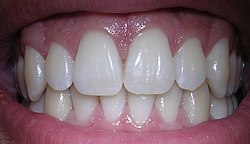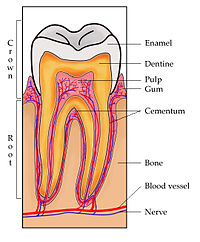Tooth

A tooth is one of the hard, white things in the mouth. Teeth (plural) are used to help the mastication process by chewing food. Chew means to break up and crush food so it can be swallowed (pushed down into the stomach).
Most vertebrates have teeth. Birds are the biggest group that do not. Many invertebrates have mouthparts which, to some extent, act like teeth. Different animals have different kinds of teeth because they eat different foods. Some animals use teeth as a weapon. Human adults usually have 32 teeth.[1] Human children usually have 20 teeth.[1]
Natal teeth
[change | change source]Some human babies are born with teeth. Natal teeth are teeth that are present at birth.[2] These are different from neonatal teeth which are teeth that emerge during the first month of life.[2] Natal teeth are not common. They occur in about 1 out of every 2–3 thousand births.[2] They are usually found on the lower jaw. Natal teeth are usually not well attached and may easily wobble.[2]
Teeth eruption
[change | change source]Deciduous teeth or milk teeth or temporary teeth are the first set of teeth for most mammals. Humans have 20 of them.[1] The first teeth (called "primary teeth") start to erupt (come through the gums of the jaw) when a baby is about 6 months old.[1] When these teeth erupt it can really hurt. Babies chew on things to make the pain better. This is called teething (verb: to teethe). Most children have all 20 teeth by two or three years of age.
At age 6–7 the permanent teeth start to erupt. By the age of 11–12 most children have 28 adult teeth. The last four teeth, called 'wisdom teeth' or third molars come in by age 17–21 in most people. Some people never grow wisdom teeth. Or they may have only two instead of four.
Teeth structure
[change | change source]

The outside white part of teeth is called the enamel. The enamel is made of calcium phosphate and is very hard. Under the enamel is the dentine. The dentine is softer than the hard enamel. So it is hurt more by tooth decay (cavities). Under the dentine is the pulp which has the nerves and blood vessels that go to the tooth. This is the part that causes the pain of a toothache. Cementum is outside the dentine where there is no enamel. Cementum holds the tooth to the bone of the jaw.
Types of teeth
[change | change source]Healthy teeth
[change | change source]If they are protected and kept clean, teeth should stay for a person's whole life. Many people lose their teeth early because they do not do the right things to keep teeth healthy.
Some things people can do to keep teeth healthy:
- Brush teeth after every meal and at bedtime with a soft-bristled brush.[3]
- Floss after every meal (but at least once a day at bedtime).[source?] Flossing should be done before brushing!
- Drink water with fluoride before brushing. Or, use a fluoride mouthrinse (but not for children under age 6).[4]
- See a dentist every 6 months for a tooth exam and tooth cleaning.
- Eat a healthy diet.
- Sugars like sucrose and glucose are bad for teeth.[5]
- Milk and cheese are good for teeth because they have calcium.[6]
- However, milk contains lactose which can cause cavities. Due to this, drinking a lot of milk can still cause cavities.
- Unsweetened (no sugar) chewing gum helps clean teeth, and makes salvia and removes food particles.[6]
- Nothing with flavor in-between meals, give your saliva the two to three hours it needs to clean teeth. The saliva can not do that if there is a continuous food film being put on to the teeth.
- Dehydration leads to less saliva production.[7] Drink plenty of water every day.[7]
Disease of teeth
[change | change source]Plaque is the soft white substance that forms on teeth when they are not cleaned. It has bacteria in it that hurt enamel. If plaque is not cleaned off, after 2 days it can become tartar. Tartar is a hard substance that forms on teeth (mostly near the gums). Tartar makes gums unhealthy and makes more bacteria grow on the teeth.
Plaque is cleaned off with a toothbrush. If tartar forms on teeth, a dentist must clean it off.
The bacteria that are on teeth eat into the enamel. Cleaning and flossing teeth, eating good foods, and having a dentist take off plaque make less bacteria on teeth. If there is too much bacteria, they eat enamel faster than teeth make enamel. This makes holes in enamel called cavities. When a person gets cavities, he has the disease dental caries. Making cavities in enamel happens slowly. But once cavities go through enamel, the soft dentine is hurt much faster. Cavities may be fixed by dentists.
Related pages
[change | change source]References
[change | change source]- ↑ 1.0 1.1 1.2 1.3 Tina Callison. "How many teeth do we have?". Colgate Oral Care Center. Archived from the original on 10 January 2016. Retrieved 10 January 2016.
- ↑ 2.0 2.1 2.2 2.3 "Natal teeth". U.S. National Library of Medicine. Retrieved 10 January 2016.
- ↑ "Brushing Your Teeth". American Dental Association. Retrieved 23 April 2016.
- ↑ "Facts About Fluoride". American Dental Association. Archived from the original on 30 April 2016. Retrieved 23 April 2016.
- ↑ Charles P. Ophardt (2003). "Sugar and Tooth Decay". Elmhurst College Department of Dentistry. Archived from the original on 22 May 2016. Retrieved 23 April 2016.
- ↑ 6.0 6.1 "The Best and Worst Foods for Your Teeth". University of Rochester Medical Center. Retrieved 23 April 2016.
- ↑ 7.0 7.1 "The Importance of Saliva". Delta Dental Plans Association. Archived from the original on 12 April 2016. Retrieved 23 April 2016.
Other websites
[change | change source]- The New Student's Reference Work Wikisource
- Tooth Citizendium
